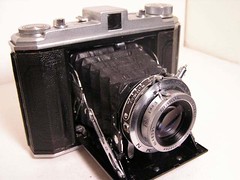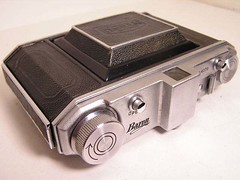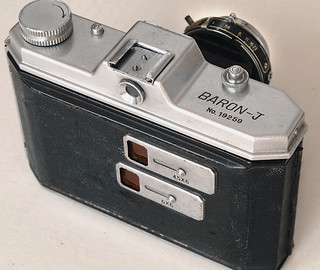Baron folders
The Baron folders are Japanese 6×6 cameras made by Chūō Seiki, later Baron Camera, from 1952 to 1956.[1]
Contents
Common features
All the Baron cameras are horizontal folders, taking 6×6cm as well as 4.5×6cm exposures. All the models share the same body casting, with folding struts inspired from the Ikonta. The back is hinged to the right, as seen by the photographer, and has two red windows, one for each format. The upper one is engraved 4.5X6 and the other 6X6.
The Baron Six
Description
The Baron Six (バロンシックス)[2] has no rangefinder. The viewfinder is half-contained in the top housing, at the centre. It seems to have translucent blue plastic strips on both sides, showing the field of view for 4.5×6cm exposures.
The advance knob is at the top left and has an arrow to indicate the winding direction. There is a decorative film flange at the top right. The body release and accessory shoe are to the right of the viewfinder and the folding bed release is to the left, with the indication OPEN engraved next to it.
The name Baron is engraved on the top housing, to the left of the finder. The serial number is inscribed in front of the accessory shoe. The initials CSK are engraved in the folding struts, perhaps for Chūō Seiki. The name BARON–SIX is also embossed in the leather on the back, under the red windows, and a CHUO BARON logo is embossed in the leather of the folding bed.
The lens is a Ciskol Anastigmat 80mm f/3.5 and the shutter is an NKS (B, 1–200) with a self-timer and an ASA bayonet synch post.
 
|

|

|

|

| |
| Baron Six no.4078, Ciskol Anastigmat 80mm f/3.5 lens no.48390, NKS shutter. Pictures courtesy of Fred Sherfy. (Image rights) | ||
Advertisements
The camera was announced in the summer of 1952 and advertised from early 1953.[3] An advertisement dated September 1953[4] shows a CHUO BARON logo and lists the distributors Misuzu Shōkai, Hattori Tokei-ten and Asanuma Shōkai, but does not give the full name of the manufacturing company.
The Baron Six was still advertised in September 1954,[5] along with the rangefinder models. The advertising picture shows an NKS-TB shutter (B, 1–200) with a PC synch post. The price was ¥10,300.
Various surviving examples have been observed, all of them with a plain NKS and an ASA synch post.[6]
The Baron-R
The Baron-RI (バロン-RI) and Baron-RII (バロン-RII) have an uncoupled rangefinder, combined with the viewfinder in a revised top housing, integrating the accessory shoe in the middle. The distance setting knob is at the right end of the top plate. It is graduated in feet and is marked Baron Camera Co. The advance knob contains a film reminder, with EMPTY, PAN, RED and COLOR positions. The folding bed release is placed at the front of the top housing, just above the folding bed itself when it is in closed position.
The name Baron-R is engraved between the viewfinder window and the round second image window. The serial number is inscribed behind the top housing on the right. The BARON–SIX embossing is still present on the back but the logo on the folding bed now reads BARON CAMERA CO TOKYO JAPAN. The CKS engraving of the folding struts has disappeared.
The shutter is a version of the NKS (B, 1–200 or B, 1–300) on the Baron-RI and a Seikosha-Rapid (B, 1–500) on the Baron-RII. The lens is a Baron Anastigmat 80mm f/3.5 on both models but the engraving differs: it is Baron Anastigmat with "Baron" in cursive style on the model I and BARON ANASTIGMAT in capital letters on the model II.
Advertisements
The Baron-R was released in mid 1954.[7] The September 1954 advertisement cited above[8] offered the two cameras for respectively ¥13,200 and ¥15,000. The shutter of the model I was given as an NKS giving B, 1–200 speeds, and it seems to have a PC synch post in the advertising picture. The Seikosha-Rapid shutter has an ASA synch post in the picture of the model II. Another advertisement dated 1954 mentions an NKS-FB (B, 1–300) but shows an ASA synch post on the model I.[9]
In advertisements by Hattori Tokei-ten dated January and April 1955,[10] the price was the same and no distinction was made between the models I and II, both called simply Baron-R.
Actual examples
Two surviving examples of the Baron-RI have been observed and two of the Baron-RII. The Baron-RI both have an NKS-FB shutter (B, 1–300) and a PC synch post; on one of these, the folding bed release is round instead of rectangular.[11] One of the Baron-RII has an ASA synch post and the other has a PC post.[12]
The Baron-J
Description
The Baron-J (バロンJ) is a viewfinder-only model, successor of the Baron Six. It has a redesigned top housing; the position of the controls is very similar except for the accessory shoe which is now above the viewfinder, and the disappearance of the film flange at the right end.
The name BARON–J and the serial number are engraved on the top housing to the right of the finder. The Baron-J has no engraving in the folding struts and it has the same BARON–SIX and BARON CAMERA CO TOKYO JAPAN embossings as the Baron-R.
The lens is a Baron-J 80mm f/3.5. It is engraved BARON–J C. where "C." surely emphasizes the lens coating. The shutter is an NKS (B, 1–200 or B, 1–300).
Advertisements
The Baron-J was introduced in mid-1955.[13] In an advertisement dated November 1955,[14] the top speed was 1/200 and the price was ¥7,500. In an advertisement dated January 1956, the Baron-J was still offered for the same price, but the advertising text announced that the factory was prepared to launch a new model. This was perhaps the Baron-F (see below).
Actual examples
The actual examples observed of the Baron-J have either 1/200 or 1/300 top speed.[15] The shutter is a plain NKS with PC synch post.

|
| Baron-J with NKS 1/200 shutter and BARON-SIX on back covering image by Geoff Harrisson (Image rights) |

|
| image by Geoff Harrisson (Image rights) |
The Baron-F
The Baron-F was announced in the December 1955 or January 1956 issues of various Japanese magazines.[16] It is said that it was a version of the Baron-J with a bright-frame finder and perhaps zone-focusing.[17] The shutter was announced as an NKS-FB (B, 1–300) with PC synch post.[18] The Baron-F perhaps corresponds to the new model announced in the January 1956 advertisement cited above;[19] it seems that it was never sold.
Notes
- ↑ Dates: advertisements and articles listed in Kokusan kamera no rekishi, p.359.
- ↑ This model is called "Baron Chrome Six" by mistake in Sugiyama, item 1279.
- ↑ Kokusan kamera no rekishi, p.359, says that it was featured in a column of the July 1952 issue of Ars Camera. The earliest advertisement listed is in Asahi Camera February 1953.
- ↑ Advertisement published in Asahi Camera, reproduced in Kokusan kamera no rekishi, p.161.
- ↑ Advertisement published in Asahi Camera, reproduced in Kokusan kamera no rekishi, p.161. See also this advertisement dated 1954, reproduced in Shashin-Bako.
- ↑ Example pictured in Sugiyama, item 1279, and examples observed in various online auctions.
- ↑ Date: advertisements and articles listed in Kokusan kamera no rekishi, p.359, start in June 1954.
- ↑ Advertisement published in Asahi Camera, reproduced in Kokusan kamera no rekishi, p.161.
- ↑ Advertisement dated 1954, reproduced in Shashin-Bako.
- ↑ Advertisements published in Asahi Camera, reproduced in Kokusan kamera no rekishi, pp.177 and 213.
- ↑ Round button: example pictured in Sugiyama, item 1280. Rectangular release: example observed in an online auction.
- ↑ ASA post: example observed in an online auction. PC post: example pictured in Sugiyama, item 1281.
- ↑ Advertisements and articles listed in Kokusan kamera no rekishi, p.359, run from May 1955.
- ↑ Advertisement published in Asahi Camera, reproduced in Kokusan kamera no rekishi, p.162.
- ↑ Example pictured in Sugiyama, item 1282, and examples observed in online auctions.
- ↑ Kokusan kamera no rekishi, p.359.
- ↑ Kokusan kamera no rekishi, p.359.
- ↑ Kokusan kamera no rekishi, p.359.
- ↑ Advertisement published in Asahi Camera, reproduced in Kokusan kamera no rekishi, p.162.
Bibliography
- Asahi Camera (アサヒカメラ) editorial staff. Shōwa 10–40nen kōkoku ni miru kokusan kamera no rekishi (昭和10–40年広告にみる国産カメラの歴史, Japanese camera history as seen in advertisements, 1935–1965). Tokyo: Asahi Shinbunsha, 1994. ISBN 4-02-330312-7. Items 693–6. (See also the advertisements for items 796 and 1043.)
- Lewis, Gordon, ed. The History of the Japanese Camera. Rochester, N.Y.: George Eastman House, International Museum of Photography & Film, 1991. ISBN 0-935398-17-1 (paper), 0-935398-16-3 (hard). P.79 (brief mention only).
- McKeown, James M. and Joan C. McKeown's Price Guide to Antique and Classic Cameras, 12th Edition, 2005-2006. USA, Centennial Photo Service, 2004. ISBN 0-931838-40-1 (hardcover). ISBN 0-931838-41-X (softcover). P.111.
- Sugiyama, Kōichi (杉山浩一); Naoi, Hiroaki (直井浩明); Bullock, John R. The Collector's Guide to Japanese Cameras. 国産カメラ図鑑 (Kokusan kamera zukan). Tokyo: Asahi Sonorama, 1985. ISBN 4-257-03187-5. Items 1279–82.
Links
In Japanese:
- Baron Six in the Classic Camera Beginners' Club
- Baron-RII at Fukumaden
- Advertisement for the Baron folders dated 1954, reproduced in Shashin-Bako